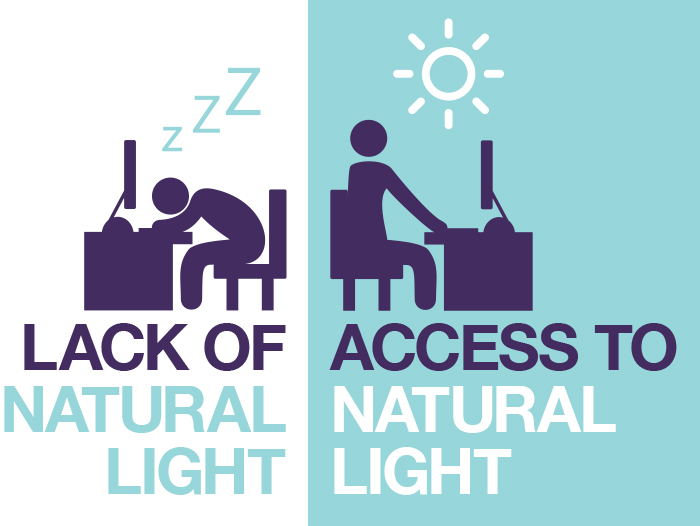The Positive Effects of Daylighting in Health & Wellness
Do you remember when you were a child, and you’d look out the window, yearning for recess to start so that you could play outdoors under the sun’s natural light?
Well…as working adults, most of us experience the same feeling. Nobody likes being stuck in a dull, dark office setting. But can natural light actually help us be healthier? The answer is a resounding yes!

Artificial Lights? No, Thank You.
If you had the choice between working in a room lit by natural light, or one lit by fluorescent bulbs, which would you choose? Most of us would prefer the former. Artificial light cannot come close to replicating the quality of natural light and its positive impact on us.
Scientists at the Lighting Research Center (LRC), in Troy, N.Y., for example, have reported that daylit environments increase occupant productivity and comfort, and provide the mental and visual stimulation necessary to regulate human circadian rhythms and the production of neural transmitters, such as serotonin.
Serotonin, sometimes known as the happy chemical, leaves us feeling more energized, happy and well-rested, while fighting and reducing stress, anxiety, depression and seasonal affective disorder (SAD). And that’s great for the health and well-being of not only working adults, but also children in schools and other learning environments.
 Increase Daylight. Reduce Pain.
Increase Daylight. Reduce Pain.
Natural light is the best medicine for the office. A recent study by Cornell University Professor Dr. Alan Hedge also found that workers in daylight office environments reported a 51% drop in the incidence of eyestrain, a 63% drop in the incidence of headaches and a 56% reduction in drowsiness
Hedge concluded that “As companies increasingly look to empower their employees to work better and be healthier, it is clear that placing them in office spaces with optimal natural light should be one of their first considerations.”
Access to sunlight can also help medical patients’ recovery. In a University of Pittsburgh study, patients who had access to sunlight required 20% less pain medication, leading to lower medical costs.
And speaking of health care, an article in Science Daily contained research from a Cornell study that showed that nurses (who work on demanding and sensitive tasks) with workstations that let in natural light, had improved alertness and a significant increase in positive sociability. And that’s just good for all of us!
The Secret Ingredient for a Happy, Healthy Workplace.
So how can you bring the outside light into your commercial space to promote a happy, productive, and healthy work environment?

Tubular daylighting is a top lighting system that distributes sunlight throughout interior spaces in your building that otherwise wouldn’t receive natural light.
This top-lighting approach captures sunlight through a dome on the building’s roof, with technology that brings it in from virtually any position within the sky.
The light is then sent down a highly reflective tube (whether through open ceilings or drop ceilings), into the space below through fixtures that deliver beautiful, diffused light.
Tubular daylighting is the simplest and smartest method of capturing natural daylight and distributing it through your workplace while minimizing heat gain.
The originator and leading innovator in tubular daylighting is Solatube.
Solatube tubular daylighting systems provide effective workplace solutions to help ensure employees feel good, are happy and more productive throughout the day. Its daylighting products improve the environments in every type of workplace and support employee wellbeing for virtually all occupations.

If you want to learn how to maximize natural light in your commercial workspace, you can call 888.SOLATUBE to set up a free consultation or visit Solatube.com to find your local distributor.
* R.P.Leslie, Lighting Research Center, Rensselaer Polytechnic Institute, 12180 Troy, NY, USA
